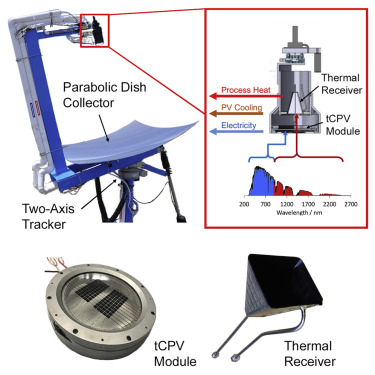According to foreign media reports, engineers have developed a new type of hybrid solar converter that uses the energy of the sun to make electricity and steam. According to reports, the device has high efficiency and low operating cost, allowing the industry to make more extensive use of solar energy. The most common way to collect energy from the sun is through photovoltaic power generation. These solar cells generate electricity from sunlight, and they are so simple that from garden lights to the grid itself, they are built into everything.

But this is not the only way. Solar concentrators collect heat instead of light, concentrate sunlight to heat the contained liquid, and then use it to generate electricity-for example as a steam-turning turbine-or more directly to heat homes or other industrial processes. Usually these two systems are separate, but people have tried to pair them into a single hybrid device, the result is often lower efficiency or higher cost. But now, the researchers claim to have created a new hybrid solar converter that combines the advantages of the two devices.
The device looks like a satellite antenna, with a small device suspended in the center of the parabolic collector. The dish part is mirrored and focuses the sunlight onto the middle box. The bottom of this part is equipped with multi-junction solar cells, which can collect visible light and ultraviolet light and convert it into electrical energy. But the smart part is that these batteries redirect infrared light—that is, thermal energy—to a separate thermal receiver higher in the device. This receiver is basically a cup-shaped cavity surrounded by pressurized water, which can capture heat and turn into steam.

The team said that the total collection efficiency is 85.1%, which means that a lot of solar energy is converted into electricity or heat. Steam can be heated to 248°C (478°F), which is much higher than many other thermal energy collectors. This means that its temperature is sufficient for many industrial processes such as drying, curing, disinfection and pasteurization.
Another advantage is cost. The team reported that once the scale is expanded, the operating cost of this hybrid device can be as low as 3 cents per kWh.
The team is composed of researchers from Tulane University, University of San Diego, San Diego State University, Boeing Spectroscopy Laboratory and Otherlab. It has received follow-up funding for the next round of development and plans to improve the technology and strive to expand the scale of the pilot plant test.
The research was published in the journal "Cell Reports Physical Science".
Shenzhen Sunson Tech Co., Ltd , https://www.sunsonkiosk.com